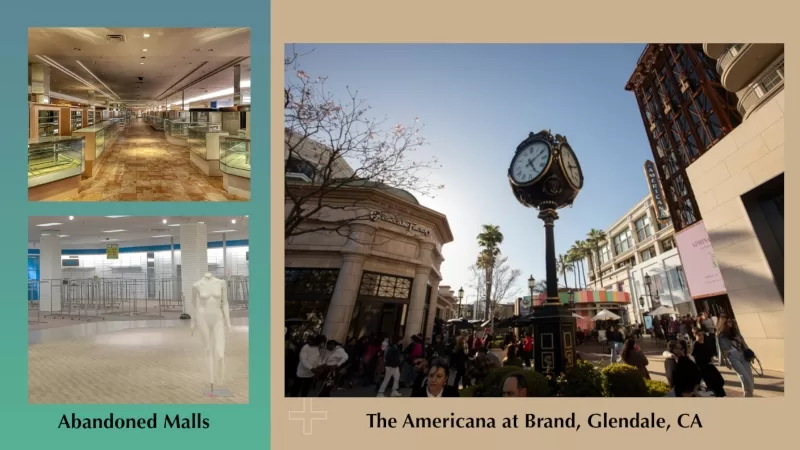A Cultural Icon in Flux
Do you remember teenagers roaming the food courts in your local mall? Or the family outings to the shopping mall on the weekend? These activities, once frequent features of suburban life, have shifted quite visibly. In the last few decades, the mall has faced significant disruption. As online shopping surges and consumer preferences shift, developers and communities alike are asking: What’s next for the mall?
Who Thought Malls Were a Good Idea in the First Place?
Following World War II, several favorable factors contributed to the migration from cities to suburbs. A booming economy, the advent of government-supported affordable housing policies, and the widespread adoption of the car were significant factors. The Federal Housing Administration (FHA) programs, along with the GI Bill, provided low-interest mortgages and loan guarantees. All these factors converged to make homeownership more accessible, particularly in the suburbs.
Opened in 1956, Southdale Center in Edina, Minnesota, became the first enclosed mall, designed by architect Victor Gruen. He designed it as a response to the rise of suburban living and the increasing popularity of car culture.
Malls provided a centralized shopping experience, all under one roof. Think of convenience and climate control (shopping in a “bubble,” whether it’s raining, windy, or snowing outside). These retail centers gave small suburban developments and towns a sense of place. With plenty of free parking, malls became the “town squares” of the automobile age.
Enclosed Malls vs. Strip Malls
The term “retail centers” can cover a lot of ground. Malls are enclosed commercial structures with a central walkway where the retail storefronts face each other.
A strip center consists of a collection of storefronts, usually aligned in a straight line or sometimes in a U-shaped configuration. A sidewalk with a covered awning runs in front of the retail stores, providing some protection from the elements, but not much.
Both centers include, for the convenience of shoppers, on-site parking.
Falling Out of Favor
At their peak in the 1980s and 1990s, malls had a golden age. Large, sprawling mall buildings contained national chains and anchor department stores. Malls became symbols of affluence and aspiration.
According to the TotalRetail site, “Zombie malls” have become eerie symbols of a bygone era, with the number of active malls in the U.S. dropping from 2,500 in the 1980s to around 700 today.
Why Did Traditional Malls Start to Struggle?
- E-Commerce and Amazon: The convenience of online shopping has made traditional retail less essential.
- Anchor Store Closures: Department store bankruptcies (e.g., Sears, JCPenney) removed the foot traffic drivers that malls relied on.
- Changing Consumer Behavior: Millennials and Gen Z favor experience, authenticity, and local flavor over cookie-cutter retail.
Are Malls Still Viable Today?
Possibly.
In the same TotalRetail post, they state that, over the past two years, mall traffic has grown steadily and significantly, with the Mall of America reporting that its foot traffic increased by 11 percent per month in 2024.
So, growth is possible, but changes are needed. The malls that are thriving have adapted by:
- Focusing on Experience: Think entertainment (cinemas, escape rooms), fitness (gyms, yoga), and food halls.
- Becoming Lifestyle Centers: Outdoor malls with walkable layouts, curated tenants, and mixed-use components are resonating more with today’s consumers.
- Serving the Local Community: Successful malls are becoming community hubs with services like healthcare clinics, co-working spaces, and event venues.
Is the Future of the Mall Mixed-Use?
First, what is mixed-use?
Examples of mixed-use malls include The Americana at Brand (Glendale, CA), which combines luxury apartments with retail, restaurants, and green spaces. Or, the Northgate Mall (Seattle, WA) that is described as Seattle’s shop, live, work, stay, play, and skate destination. It was redeveloped into a transit-oriented neighborhood with housing, healthcare, and the Seattle Kraken’s NHL practice facility.
Marin is slowly moving forward with a redevelopment plan for Northgate Mall, now known as Northgate Town Square in Terra Linda. This location is not without its detractors, but according to the City of San Rafael’s website:
“On February 25th, the Northgate Town Square redevelopment project has officially received the green light from the San Rafael City Council after the approval of key land entitlements, marking a major milestone for the City’s ongoing efforts to revitalize the Northgate area. This significant development is expected to transform the former mall location into a pedestrian friendly hub with a blend of residential, retail, and open spaces designed to meet the evolving needs of the community.”
What Keeps Malls Relevant in 2025 and Beyond?
- Community-Centric Design: Programming like farmers markets, live music, or maker spaces attracts locals.
- Blending Digital and Physical: Showrooms, “click-and-collect” models, and immersive brand experiences bridge e-commerce with brick-and-mortar.
- Health and Wellness Anchors: Medical offices, urgent care clinics, and wellness studios are new staples.
- Flexible Space: Pop-ups and rotating vendors keep the space dynamic and fresh.
Reinventing the Mall — Not Replacing It
The mall isn’t dead, but it is evolving. Some feel it is long overdue. Others may have valid concerns about increasing density and traffic. Where once they were purely retail centers, today’s malls are transforming into multi-dimensional community spaces. With a focus on experience, convenience, and mixed-use vitality, the mall may be stepping into its most innovative era yet.


